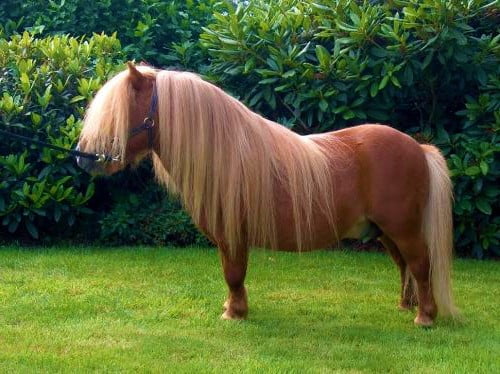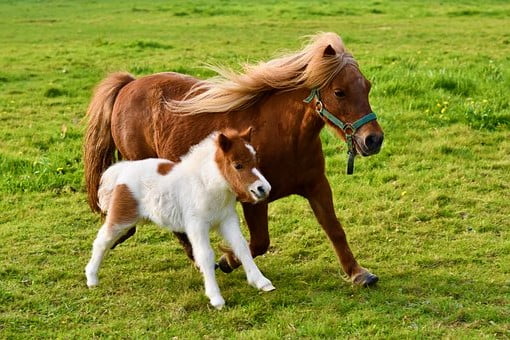pony

pony
11 Interesting Facts About Ponies
For many young pony riders, this is the first point of contact with the equestrian world. Ponies are great for beginners as they are less intimidating than horses and can be good-natured and dependable if properly trained.
The word “pony” actually comes from the old French word “poulenet” which means pony. Although horses and ponies belong to the same species , they differ greatly in appearance and temperament.
Thanks to modern breeding, there are more than 200 pony breeds in the world today. Many of them originated in harsh northern climates or mountainous areas, while others are descended from crossbreeding existing breeds of horses and ponies. Smart and friendly, ponies can make great companions or companions in the right hands.
Here are eleven interesting pony facts!
1. Ponies share a common pedigree with draft horses.

Most sources agree that ponies originally descended from the “painted” subtype horses that were common in Northern Europe. Due to the harsh climate and lack of food, the ancestors of modern ponies became smaller and smaller, eventually forming a new type of horse.
One theory even suggested that ponies were descended from a “rough” line of Equus ferus , the original wild horse. However, genetic studies have refuted this theory.
Throughout history, ponies have proven to be useful in a variety of roles. These strong, stable little horses were ideal for pulling wagons and hauling heavy loads over rough terrain. Small farmers also preferred to pull horses because it was cheaper to keep enough manpower for farm work.
As equestrianism grows in popularity, more and more pony breeds are being bred for children and young adults. When creating a new breed of pony, breeders often use Arabian blood to give refinement and athleticism. For example, the Welsh pony has had a significant Arab influence on its history.
2. All ponies up to 14.2 hands (148 cm)

The International Federation for Equestrian Sports (FEI) draws the boundary between horses and ponies at 14.2 hands or 148 cm. If the horse is shod, the end point is 14.25 hands or 149 cm. However, in most competitions a margin of 0.5 or 1 cm.
However, some horse breeds mature above this height, while some horse breeds mature continuously. It may seem confusing at first, but we will explain it later in the article.
To complicate matters further, some countries have different rules. In Australia, for example, horses between 14 and 15 hands are called a “loop”, while ponies must be under 14 hands (142 cm).
In the show world, ponies are often divided into three classes. These are small (12.2 yards / 127 cm), medium (12.2-13.2 yards / 127-137 cm) and large (13.2-14.2 yards / 137-148 cm).
In response to growing demand, many modern horse breeds today have pony versions. A good example of this is the Quarter Pony, which is a smaller version of the popular Quarter Horse breed. This is how the hackney pony was born, very popular in driving competitions.
3. All horses have at least 14.2 ponies.
As mentioned above, there are many breeds that mature to 14.2 hands and are still called horses today. This is usually because they are more like horses than ponies and can easily carry an adult adult. These horse breeds are traditionally used for riding and are classified as “horses” in competition.
Here are some examples of pony-sized horse breeds with average height in brackets:
- Haflinger (13.2-15 networks)
- Icelandic horse (13-14 hands)
- Arabic (14.1-15 hands)
- Caspian Horse (9-11.2 hands)
- Ford Horse (13.1-14.3 hands)
- Mongolian horse (12-14 hands)
- Khors Quarter (14-16 networks)
- Yakut horse (13.2-13.3 hands)
- Camargue horse (13.1-14.3 hands)
Interestingly, some of these breeds, such as the Fjord Horse or the Icelandic Horse, have typical pony traits but are still considered “horses” in their breeding societies. However, not all breeders and owners agree on whether horses or ponies should be named.
On the other hand, some pony breeds, such as the Chincoteague wild pony, can grow to over 14.2 hands. Since these ponies live and breed in the wild, their size usually depends on their genes and the quality of the food they receive.
There are also cases where people refer to normal-sized horses as “ponies”. This refers to polo ponies or horses that are used to ride racehorses on a track. In addition, many horse owners affectionately refer to their horses as “ponies”, regardless of their actual size.
4. Miniature horses are not ponies.

Oddly enough, the smallest horses in the world are not called ponies, but horses. Miniature horses stand well below the minimum horse height and usually do not exceed 9.2 hands (97 cm) at the withers.
The smallest horse breed in the world, the Falabella, has an average of only 8 arms! It was bred from a mixture of Criollo, Welsh pony, Shetland and Thoroughbred breeds.
The reason why these small horses are considered horses has less to do with their size than with their looks. Miniature horses are supposed to be miniature versions of their grandparents. They have little or no pony characteristics such as relatively short legs, rounded barrels, or bushy manes and tails.
5. Ponies have a specific shape.
As already mentioned, ponies differ from horses not only in size, but also in physique. Compared to their larger cousins, ponies have shorter legs in relation to their body, a larger head with large eyes and small ears, thicker necks, and heavier bones. They also have a very soft winter coat and wear exhibits and fluffy tails all year round.
In general, ponies appear rounder than horses, although there are many exceptions. Sport pony breeds such as the Connemara or Pony of the Americas have slender, athletic, equine bodies.
These small horses also have strong and resilient hooves that allow them to move through unforgiving terrain. Ponies have inherited much of their distinctive traits from their ancestors, which they developed thousands of years ago.
6. The use of ponies to work in the mines during the industrial
revolution.

Along with many women and children, a large number of horses and ponies were forced to work underground in the coal mines. These horses were called “pit ponies” regardless of their size, and were common in the mines between the mid- eighteenth and mid-twentieth centuries.
The use of miniature ponies such as Shetland and miniature ponies was popular in Britain, especially after a new law exempted women and children from working in coal mines in the 1840s. Welsh ponies, Dartmoor ponies and Cornish ponies were also often used to work in small tunnels. , while larger horses like Cleveland Bay worked higher underground.
Unfortunately, most young ponies lived their lives in poor conditions underground, never seeing the sun again. Many of them became blind and suffered from other diseases. The last Ponies mine was the Drummond Coal Company mine in Westville, Nova Scotia which closed in 1978 .
7. Ponies are very versatile.
In general, ponies are known for their strength and power, excellent endurance, and good work ethic. Traditionally, they were mainly used as mounts, mounts, and pack animals, although people used them for a variety of purposes.
In modern society, ponies have proven their worth in a wide variety of equestrian roles. Due to their small size and forgiving nature, they make excellent teachers for beginners and children. Well trained ponies are ideal as a first pony for those learning to ride.
In addition to riding, ponies also excel in competition, even against larger horses. Breeds such as the New Forest Pony or the Australian Pony are great for jumping, dressage or pony riding.
In addition, the Hackney Pony is a great choice for competitive driving enthusiasts. Other British breeds such as the Welsh Pony or the Shetland Pony are suitable for both riding and driving.
Ponies can also make exceptional therapy horses for people with physical or mental disabilities. Their relaxed backs and gentle dispositions are a valuable asset to equine therapy centres.
8. Ponies have a special temperament.
While ponies generally have a calm and friendly personality, some people claim that they can be stubborn and even cunning at times. It is not uncommon for owners to refer to their ponies as “sassy”, “naughty” or “little devils”.
The truth is that ponies are very smart and quick-witted, but also cuddly. For this reason, their daily behavior and attitude towards work often depends on the quality of the training they receive. Ponies trained by inexperienced trainers who do not set clear boundaries can easily pick up bad habits.
9. Ponies are strong for their size.
Due to their high bone density and stocky build, ponies are surprisingly strong for their size. This is why larger ponies like the Connemara can be easily ridden by adults without putting too much strain on the animal’s physique.
Did you know that Shetland ponies are the strongest of all pony breeds for their size? These little ponies can pull 4.5 times their own weight, more than most horses can handle!
In addition, draft ponies, like many breeds of British mountain and marsh ponies, can carry loads similar to those of draft horses. Considering everything they bring to the table, ponies are truly underrated.
10. Ponies are generally easy to keep.
Most pony breeds are naturally hardy and able to thrive on minimal food all year round. As a general rule, ponies require half as much hay per unit of body weight as horses to maintain optimal fitness. Ponies rarely need concentrated feed unless they are doing hard work.
On the other hand, this highly efficient metabolism has a downside: ponies can gain weight quickly when there is plenty of food. As a result, pony breeds are more susceptible to diseases such as laminitis and Cushing’s syndrome. To stay healthy, ponies need a proper diet for weight control and regular monitoring.
11. Ponies, on average, live longer than horses.
While the average lifespan of a horse is 20 to 30 years, it is not uncommon for ponies to live into their 40s. Of course, this depends on many factors such as genetics, nutrition and care. However, ponies tend to live longer than horses.
According to the Guinness Book of World Records , the oldest pony on record was Sugar Puff, who lived to be 56 years old before being shot by his owner in 2007. His age is 150.5 years in human terms !
Sugar Puff was a 10-handed Shetland-Exmoor cross-country pony who lived in West Sussex, UK. It was acquired by the last owner, Sally Botting, when he was 29 years old. Sugar Puff even taught daughter Sally how to ride!
According to the owner, everyone in the family adored Sugar Puff until the last minutes of their lives. “He was such a safe and reliable pony – we taught the kids to ride him at school events. He was also old at the gym and at the Pony Club. He was such a fun pony – he came home for Christmas.” Sally Botting narrated Horse and the Hunt .




